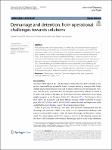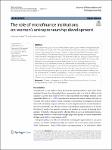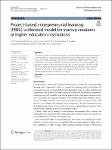Search
Author
- Marina, Dabić (3)
- Christa, Sys (2)
- Domingo, Ribeiro-Soriano (2)
- Gittell, Ross (2)
- next >
Subject
- kinh tế (26)
- Economics (12)
- Management science (7)
- Development Economics (6)
- next >
Date issued
- 2020 - 2023 (306)
- 2010 - 2019 (47)
- 2009 - 2009 (1)
Has File(s)
- true (354)
Search Results
The label “phygital” (physical plus digital) has been proposed to describe how companies try to engage customers due to the exploitation of smart technologies. Although used mainly by practitioners, research into phygital’s theoretical development is lacking. We conduct a systematic literature review to obtain an overall vision of the phenomenon and to understand how the scientific debate uses the term. The in-depth analysis allows for the identification of four main aspects: (1) objects and applications, (2) context (space/place), (3) customer journey, and (4) shopping (retail) experience. Using the antecedents, decisions, and outcomes model, we offer an interpretation of the phenomenon in a more comprehensive framework. The development and use of physical and digital objects and a... |
Entrepreneurial firms are central actors in the process of the generation and diffusion of digital innovation which, on the other hand, provides a wide range of opportunities for entrepreneurs. Although existing research has produced several contributions on both topics, the knowledge generated in the field appears fragmented and the findings are sometimes ambiguous. The reason for this fragmentation can be traced back to the lack of reference frameworks that clarify the most used concepts, thus providing a shared language. This study aims to consolidate the state-of-art of scholarly research published over the past 20 years at the intersection of the innovation and entrepreneurship fields of study. To this aim, we carried out a systematic literature review by analyzing a set of 185... |
Reduced free time and increased fees for demurrage and detention create organizational challenges with respect to intermodal transport. As a result, actors within the maritime supply chains are confronted with greater complexity and higher risk of costs; and, therefore, often fall back on transportation by truck to and from the hinterland. That is why the present research examines the impact of this evolution on the bottom line of the involved actors from a maritime supply chain perspective. The research approach consists of reviewing the relevant literature, analyzing the available sector data obtained through interviews and professional experience, and validating the proposed solutions. |
In this work, we consider a novel single-server retrial queue with event-dependent arrival rates. Contrary to other related works, the primary customers’ arrival rates depend on the last realized event, which refers either to a departure, or to an arrival of either type, or to when a customer arrives during a busy period, compared with others. Our motivation stems from the modeling of service systems, in which the customers express their willingness to join the system based on the last realized event. We investigate the stability conditions, and derive the stationary distribution both at service completion epochs, and at an arbitrary epoch. We also study the asymptotic behaviour under high rate of retrials. Performance measures are explicitly derived, and extensive numerical example... |
This study investigates the role of microfinance services on women's entrepreneurship development in Assosa town. The study employed both descriptive and explanatory designs and a quantitative research approach. The study targeted 352 women clients of Assosa Woreda Microfinance Institution, and 165 samples were selected using a simple random sampling technique. The data were collected through a questionnaire and analyzed through the statistical package for social science (SPSS) 26 software. The findings from the descriptive mean analysis indicate that the microfinance institution financial and non-financial services offered were found unable to significantly empower disadvantaged and poor women by improving their livelihood and development of their business. |
This paper proposes a solution scheme for the problem of scheduling deliveries from distribution centers. The solution scheme is developed in two phases. The first phase corresponds to the collection and processing of data, and the second phase includes the design of a customer assignment model based on the data of the first phase. The first phase provides the characteristics of the customers, the number of orders to be dispatched, and the number of visited customers. In the second phase, optimization techniques are used, considering scheduling and assignment problem-solving methodologies. The optimization model provides the correct assignment of customer orders to vehicles, reducing the number of trips and the fleet's size and occupation percentage. |
This research aims to describe the dynamics of applying project-based entrepreneurial learning (PBEL) in creating startups at higher education institutions. Action research was used for eight participants as the research method by applying the PBEL model in the form of a narrative method. The results revealed that all university students can produce products, starting from prototypes until business products. The PBEL model drives successful startups. For the more effective startups, the PBEL model needs to add network marketing and funding to be applied. Future research is expected to address questions from the results of this study. |
Returns handling in e-commerce How to avoid demand negativity in supply chain contracts with returns E-commerce constitutes a system for the online purchase and sale of services and commodities. This theoretical article investigates the manufacturer handling strategy which occurs in online shopping, in a centralized or decentralized channel under the wholesale price contract. The retailer’s optimal order quantity, price, and the manufacturer’s wholesale price are derived assuming additive uncertainty in demand. The possibility of negative demand realizations, which may occur in adverse market circumstances, is verified in the investigated models. It was proved that the imposition of the non-negativity prerequisite on demand is vital to obtain complete results. The non-negativity constraint in this study incorporates consumer’s returns handling costs which is different than the prev... |
Distributed Ledger technology (DLT) has recently emerged as a disruptive system with a wide range of applicability, with prospect to improve societal interactions at large. In virtual enterprise (VE) context researchers and practitioners have started to investigate the deployment of DLT to automate the processing of data and implementation of decisions to support the provision of digital services. Although academic interest in this domain is growing, a practical analysis of DLT from a governance perspective is still lacking to date. Accordingly, this study aims to fill this gap and provide implications related to decentralized governance of DLT. This article develops an architectural governance-by-design framework that defines the governance of DLT as a combination of architectural ... |
This paper studies a prediction problem using time series data and machine learning algorithms. The case study is related to the quality control of bumper beams in the automotive industry. These parts are milled during the production process, and the locations of the milled holes are subject to strict tolerance limits. Machine learning models are used to predict the location of milled holes in the next beam. By doing so, tolerance violations are detected at an early stage, and the production flow can be improved. A standard neural network, a long short term memory network (LSTM), and random forest algorithms are implemented and trained with historical data, including a time series of previous product measurements. Experiments indicate that all models have similar predictive capabili... |










